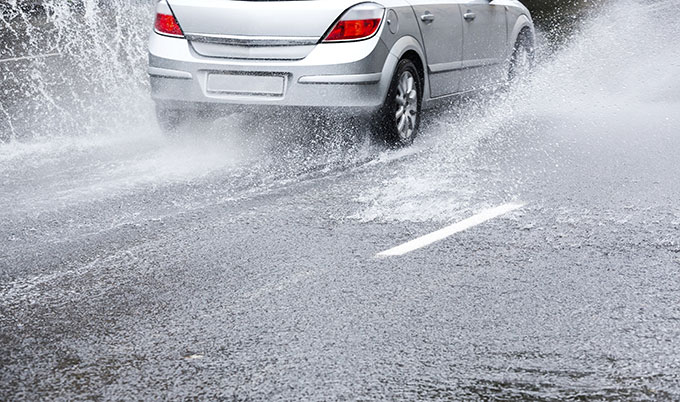Comment: Heatwaves and flash floods
Comment: Heatwaves and flash floods - Britain's new normal
Published on: 2 August 2019
Writing for The Conversation, Professor Hayley Fowler discusses why we should expect heatwaves and flash flooding to happen more often.

“It’s hard to believe, isn’t it, that we had a heatwave just last week?”
Those words were spoken by a BBC news presenter, in front of graphic images of fire service rescues, as heavy rain caused floods and landslides which closed many roads and railway lines. In recent days there have dramatic floods across the north of England, particularly around Manchester, the Peak District and Yorkshire.
For me, this is personal, as I am from the worst affected area. I went to high school where people spent the night in their Civic Hall. Three miles away from where I grew up, a dam holding back Toddbrook Reservoir has been at risk of collapse and the town of Whaley Bridge was evacuated. But I’m not surprised that we are seeing flash flooding and I expect it to get worse in the future.
I am a professor at Newcastle University, where I lead a large research group focused on understanding changes to intense rainfall events and flash floods. Over the past eight years we’ve been working closely with colleagues at the UK Met Office to develop new very high-resolution climate models that can simulate these very intense summer storms and therefore predict what might happen in a warming climate.
Our models tell us that by 2080 summers in the UK will be much hotter and drier. Heatwaves will be more common. In fact a report released by the Met Office on the same day as the latest flash floods tells us that heatwaves are already happening more often. When Cambridge recently hit 38.7℃, the UK became one of 12 countries to break its national temperature record this year.
The world is warming. But although UK average summer rainfall is predicted to decrease, our models tell us that when it does rain it will be more intense than has been the case. Flash flooding in the UK is generally caused by intense rainstorms, where more than 30mm falls in an hour. Climate models predict these will happen five times more often by 2080.
Part of the reason for this is the simple fact that warmer air can hold more moisture. But that’s too simple: the availability of moisture also increases in areas close to warm oceans – warmer sea surface temperatures cause more moisture to be evaporated into the atmosphere, providing additional fuel for these intense storms. And here’s the scary bit: the Atlantic Ocean provides a vast source of moisture for storms in the UK.
But that’s not the whole story. Heavy, short rain storms are intensifying more rapidly than would be expected with global warming (what we call the Clausius-Clapeyron relationship). Research also suggests that more intense storms can themselves grow bigger, and with both the intensity of the rainfall and the spatial footprint of the storm increasing, the total rainfall in an “event” could double.
What’s more, the larger storms seem to have an ability to draw in more moisture from the surrounding area and become even more intense: the additional energy (heating) fuelling the uplift of air within the storm’s core draws in even more moisture from the surface, allowing them to grow even larger, with more potential for flooding. These also provide the perfect ingredients for large hail storms.
So, it is entirely consistent that we might expect both more heatwaves and more intense summer thunderstorms in a warmer climate. We also know which areas of the country are already susceptible to these flash floods from our analysis of historical records of flooding. Newspapers have reported on the dramatic impacts of these floods for centuries and this has allowed my team to reconstruct a flash-flooding history of the UK.
Certain parts of the country are highly vulnerable as their rivers respond quickly to rainstorms. These rivers tend to be found in steep, upland catchments underlain by non-permeable rocks, mainly in the north and west of the UK. High-risk catchments also include urban areas where the ground is also non-permeable, for entirely different reasons.
Many of the towns reported to have suffered “biblical” flooding recently have suffered repeated flooding through history, but perhaps not within living memory. For example, Whaley Bridge is mentioned twice in the flood chronologies for events in June 1872 and July 1881:
On 19th [June 1872] the Goyt was 12 to 14 feet above its normal level. At Whaley Bridge houses near the river were completely flooded and people were taken into the chapel and inns … in Macclesfield a woman and child were drowned when the river Bollin overflowed. Two reservoirs burst in the vicinity.
This rich archive of knowledge, including the prevalence of flooding in certain towns, even specific roads, is something we should draw upon in planning both the emergency response to these flash floods and for reducing their future impact. We can learn a lot from the past in how to manage the greater risks of flooding the future will bring.
Hayley J. Fowler, Professor of Climate Change Impacts, Newcastle University
This article is republished from The Conversation under a Creative Commons license. Read the original article.



